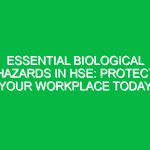Introduction
Good morning, team! Today, we’re having an important toolbox talk focused on a topic that can significantly impact our Safety—Tornado Safety. Tornadoes are unpredictable and can cause catastrophic damage in a matter of minutes. It’s crucial that we understand how to protect ourselves and our coworkers in the event of a tornado, especially while on the job. This discussion aims to equip you with the knowledge and tools you need to stay safe and respond effectively should a tornado occur.
Understanding Tornadoes
Before diving into safety tips, let’s briefly discuss what tornadoes are. A tornado is a rapidly rotating column of air that extends from a thunderstorm to the ground. They can vary in size and intensity, and tornadoes are rated on the Enhanced Fujita scale, ranging from EF0 (weak) to EF5 (incredible). Understanding the characteristics of tornadoes helps us appreciate the importance of Safety Measures.
The Importance of Tornado Safety in HSE
In the context of Health, Safety, and Environment (HSE), tornado safety is vital for several reasons:
- Protection of Lives: The primary goal of any safety protocol is to protect workers from harm.
- Minimizing Property Damage: Implementing Safety Measures can help reduce the extent of damage to company property.
- Legal Compliance: Adhering to safety Regulations helps us comply with legal obligations, ensuring the company is not liable for accidents.
- Maintaining Productivity: Ensuring safety can help maintain smooth operations, preventing disruptions caused by tornado incidents.
Recognizing Tornado Conditions
Recognizing the conditions that lead to tornado formation is critical for our safety. Here are some indicators:
- Severe thunderstorms with heavy rain.
- Dark, low-lying clouds.
- Strong, rotating winds.
- Large hail or loud, continuous roar like a freight train.
Being aware of these signs can help you take action before a tornado strikes.
Emergency Preparedness and Planning
Preparation is key when it comes to tornado safety. Here are some proactive steps to take:
- Identify Safe Locations: Know where the designated safe locations are within your workplace. These could include basements or interior rooms on the lowest floor, away from windows.
- Create an Emergency Plan: Work with your team to develop an emergency response plan specific to tornadoes. Ensure everyone knows their roles and responsibilities.
- Conduct Drills: Regularly practice tornado drills to ensure everyone is familiar with the emergency Procedures.
- Stay Informed: Use weather apps or local alerts to stay updated on severe weather warnings.
During a Tornado: What to Do
If a tornado warning is issued while you are at work, follow these crucial steps:
- Seek Shelter Immediately: Move to your pre-identified safe location without delay.
- Protect Yourself: Get under something sturdy, like a heavy table, and use your arms to protect your head and neck.
- Stay Away from Windows: Flying debris can shatter glass, so it’s essential to keep clear of windows.
- Listen to Instructions: Pay attention to emergency personnel and follow their instructions. They are trained to handle such situations.
After the Tornado: Recovery and Assessment
Once the tornado has passed, it’s important to handle the aftermath correctly:
- Check for Injuries: Ensure everyone is accounted for and check for injuries. Administer first aid if necessary and seek medical attention for serious injuries.
- Inspect the Building: Look for any damages to the structure before re-entering. If it’s unsafe, wait for emergency personnel.
- Report Incidents: Document any injuries or property damage and report them to your supervisor.
- Stay Informed: Continue to listen to emergency updates and follow local authorities’ guidance.
Real-Life Example: A Tornado Scenario
Let’s consider a hypothetical scenario to put our knowledge into perspective. Imagine it’s a sunny day, and you’re working at a construction site. Suddenly, the sky darkens, and the wind picks up. You notice an alert on your weather app indicating a tornado warning in your area. What should you do?
First, you should immediately gather your coworkers and head to the designated safe area. As you move, you should instruct everyone to stay calm and avoid running or panicking. Once in the safe location, you and your team should huddle under a sturdy table, covering your heads with your arms. After the tornado passes, you can assess the situation together. This scenario highlights the importance of preparation and teamwork.
Best Practices for Tornado Safety
Here are some Best Practices to keep in mind for effective tornado safety:
- Be Proactive: Always be aware of changing weather conditions and have a plan in place.
- Communicate Clearly: Ensure everyone on the team understands the emergency procedures.
- Use Technology: Leverage weather apps and alerts to receive timely information.
- Participate in Training: Attend all safety training sessions and drills to stay prepared.
Open Discussion: Your Thoughts on Tornado Safety
Now that we’ve covered a lot of ground regarding Tornado Safety, I’d like to open the floor for discussion. What are your thoughts on the safety measures we’ve discussed? Do you have any questions or additional insights based on your experiences? Your input is invaluable in ensuring we all understand and commit to these protocols.
Regulations and Standards
It’s also important to understand that our company policies regarding tornado safety align with local and national safety regulations. Compliance with Occupational Safety and Health Administration (OSHA) standards ensures that we prioritize our safety during severe weather events. Familiarizing yourself with these regulations not only keeps us safe but also protects our company legally.
Conclusion
In conclusion, Tornado Safety is a critical component of our Health, Safety, and Environment strategy. By understanding the nature of tornadoes, preparing adequately, and knowing what to do during and after a tornado, we can significantly reduce the risk of injury and damage. Thank you for your attention today and for your commitment to maintaining a safe work environment. Remember, safety is everyone’s responsibility, and together we can ensure a secure workplace for all.


